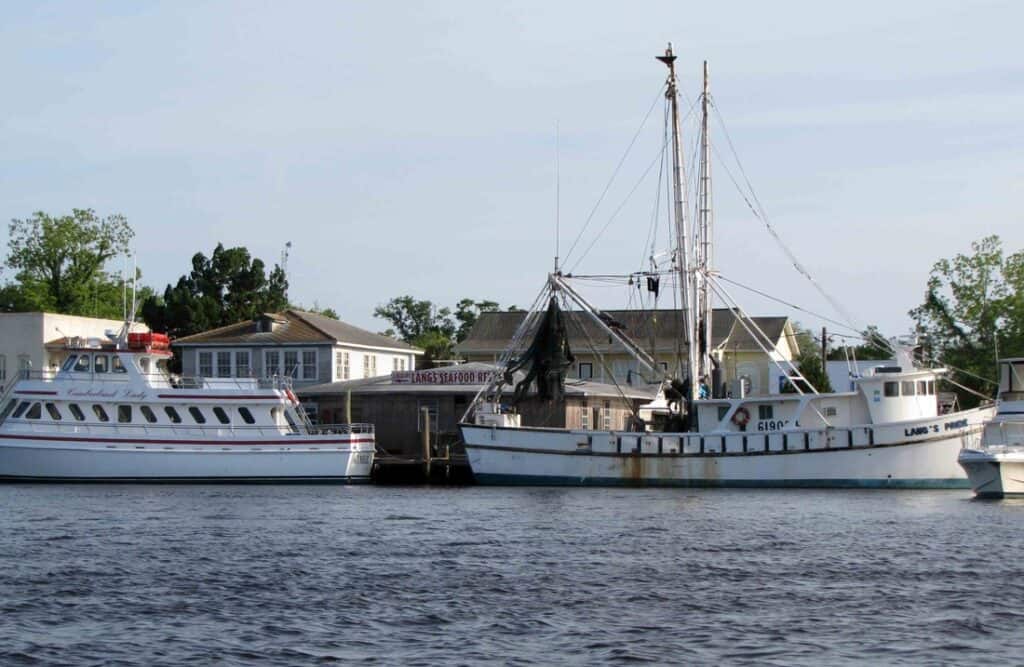Shrimp and Grit: The St. Marys River and Its Tumultuous Past

We all have our favorite activities on the St. Marys River: taking in a sunset at the waterfront park, crabbing from the pier, or riding boats on the river’s glassy surface. We also enjoy its bounty, especially shrimp, as we look forward every year to our biggest local event: October’s St. Marys Seafood Festival. However, the river was not always peaceful as it is today, as countless traders (and smugglers) plied its waters. Below learn about the action the St. Marys River has witnessed and the rise of the local shrimping industry.
The St. Marys River, which marks the boundary between Georgia and Florida, forms at the Okefenokee Swamp, meanders east approximately 150 miles, and ends at the Cumberland Sound outside St. Marys. It is known as one of the most crooked rivers in the world and one of the deepest for its width in North America. Centuries ago, seafarers world-wide knew it as a source of pure drinking water; ships would sail hundreds of miles off course to secure this river’s water for long voyages.
The depth of the river made it ideal for establishing a port. In fact, after Georgia became a state in 1777, a port sprung up in the St. Marys area a decade before the town did. By the early 1800s, St. Marys boasted the customs house for this region, and boats delivered daily such necessities as salt, sugar, coffee, and gunpowder and carried away local cedar and oak.
However, trade at St. Marys was not always an innocent affair. The Embargo Act of 1807, aimed primarily at warring England and France, closed American ports to foreign trade. Facing ruin, local merchants turned to illicit trade with Spanish Florida, taking advantage of the St. Marys River’s inlets and isolated landings. During this time boatyards along the St. Marys were extremely busy; small boats especially were in demand as they could more easily maneuver the river’s tucked-away corners for these unlawful rendezvous.
Even after the removal of the Embargo Act, St. Marys remained a busy port and shipbuilding town; in fact, The Savannah Georgian reported in 1837 that more vessels had been built here than at any other port in Georgia. Shipbuilding contributed to the local economy into the last century, as well. Several boatyards turned out yachts, barges, shrimp boats, and in the 1950s, even patrol gunboats for the U.S. government.

The early 1900s saw St. Marys take advantage of its local shrimp. J.S.N. Davis, Jr., and George W. Brandon turned an old sawmill near Oak Grove Cemetery into a shrimp (as well as sweet potato and string bean) canning plant, and by 1912 three other canning businesses had sprung up. These plants hired many locals to head and peel shrimp, reviving a stagnant economy.
Refrigeration was essential to St. Marys’ shrimping industry. In the 1930s, an ice plant opened on St. Marys Street just when such names as Dickey, Miller, and Lang were pioneering the local shrimping industry. Shrimping here became a big business; in its heyday, as many as thirty boats operated from St. Marys, delivering their catches to one of three docks downtown. St. Marys shrimpers unloaded more meat here than anywhere on the East Coast, and the ice plant allowed them to send their catches long distances by train and truck.

Calvin Lang is credited with making rock shrimp a local delicacy. Because of rock shrimp’s hard shell, shrimpers would push it overboard, but by the early 1980s Lang purchased a peeling machine and produced 2,000 pounds of meat daily. Thanks to his distributing this shrimp with its lobster-like flavor across the country, St. Marys became known as the Rock Shrimp capital.
Around this time, Lang and the St. Marys Kiwanis Club allied to solve their respective problems: the Club had difficulty obtaining fresh fish for their seafood festival, while Lang struggled finding a market for his rock shrimp. Their collaboration created the only rock shrimp festival on the East Coast.
Now dubbed the St. Marys Seafood Festival, this year’s event on October 1 marked the kick-off for Cumberland Island National Seashore’s fiftieth anniversary. From a 5- and 10k run to a parade featuring floats, from arts and crafts demonstrations to seafood concessionaires, the festival provide a fun-filled day for all every year! Tune in soon for a look back at Cumberland’s fifty years as a national park!
Want more history on St. Marys? Join a St. Marys Walking Tour!


